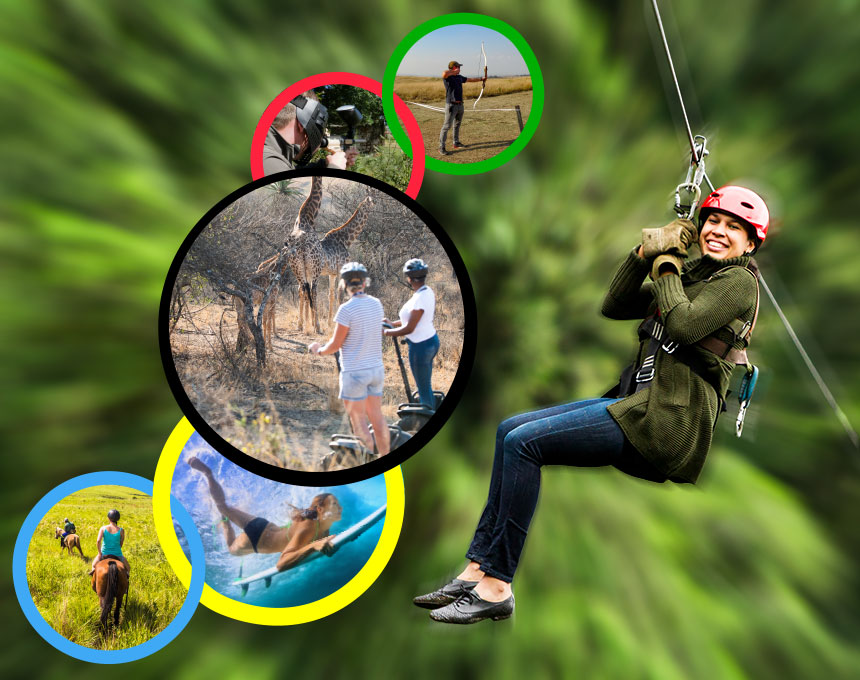
News / 26 February 2025
Birding Hotspot: Finfoot Lake Reserve
Author: Faansie Peacock
Listen to this story (11 min):
When meeting a whole group of strangers for the first time there is always a bit of shy awkwardness. Everyone stands about, clustered in little peer groups, surreptitiously stealing glances at each other and sussing things out. But as birders we soon get over it. All it takes is one bird to fly into the trees above. And in this case it was a pretty special bird at that! Suddenly, two Great Spotted Cuckoos were just…there. They put up a huge racket and soon every myna and starling in the camp seemed to be on their tail. Quite literally: viciously attacking them and yanking out clumps of cuckoo feathers. The kids were running about below them, plucking plumes as they drifted downward. What a special way to kick off the weekend!

ABOVE: Great Spotted Cuckoo by Anton Kruger.
I had been invited by Dream Hotels & Resorts to host a birding weekend at Finfoot Lake Reserve, on the shores of Vaalkop Dam in SA’s North-West Province. A quick flight up from Cape Town to Lanseria, and then a pleasant 1.5 hours’ drive in my little rental car, and I was watching Shaft-tailed Whydahs, Ashy Tits and Marico Sunbirds in prime Bushveld. We had an exciting weekend planned, including bush walks, game drives, a barge cruise on the dam and even a night drive to look for owls and nightjars.

ABOVE: Amongst various other accommodation options at Finfoot, this self-catering house can be booked in its entirety.

ABOVE: Another option is the luxury safari tents. We stayed in the beautiful but more simple bush chalets.
Half-jokingly, I had posted on our weekend Whatsapp group that people should keep an eye open for the localised Yellow-throated Sandgrouse as they drive to Finfoot along the Sun City road. The habitat looked great, but this not an easy bird to connect with. So I’ll admit to a pang of jealously when the guests arrived and showed me back-of-cameras of this very sandgrouse in the fields!

ABOVE: Great Spotted Cuckoo by Anton Kruger. Keep an eye open for these on the way to Finfoot.
If you’ve ever gone birding with me, you’ll know that I am a certifiable coffee addict. So when I entered my room and spotted a coffee machine - with a selection of pods - the drive from Lanseria was soon forgotten. As the sun rose on Friday morning, I nestled a steaming mug, sitting on the edge of the stoep with my bare feet on the soil. The simple pleasures! A pair of glossy green dung beetles rolled past my toes and a sleepy lacewing flopped past. Then a small black shape came floating into my field of vision. Then another, and another, and another. Soon the bush was filled with little black shapes. Handmaidens: slow-flying, day-living moths with black and yellow wings.
Whilst I was on my entomological tangent, the dawn chorus was in full swing. The usual culprits were much in evidence: Natal Spurfowls, Red-crested Korhaans, White-browed Scrub Robins, Piet-my-vrous, Brubrus, Chinspot Batises, Willow Warblers… My morning’s bird list was skyrocketing upward, and showing no sign of abating. I watched a preening Grey Tit-Flycatcher for quite some time, hoping in vain that it would lead me to its nest. But I did find a nest of a pair of Southern Grey-headed Sparrows in a dead stump behind my chalet. I enjoyed watching a family of Southern Black Flycatchers hunting on the lawn, and managed to get a pretty decent recording of a Southern Black Tit with my phone.

ABOVE: The exquisite Golden-breasted Bunting is common around Finfoot. Picture by Anton Kruger.

ABOVE: The antics of Red-billed Buffalo Weavers kept us entertaining all weekend. They have a very fascinating sex life, but I thought it best not to go into too much detail with all the kids around. Photo by Anton Kruger.
After a scrumptious dinner we strolled across to the conference venue for a fun bird quiz. Games included ‘spot the nightjar’, ‘match the parasite to the host’, ‘ID the raptor by its silhouette’ and ‘read the sonograms’. The youngsters dominated in this competition, but I have a feeling that the parents were all too happy to take second place to their brainy and bird-crazy kids. Eventually I had to call it quits close to 22:00 - we still had a brilliant day’s birding ahead of us on Saturday.
Bright and early our birding group assembled on the lawn by reception, where a violent and noisy battle between two Red-billed Buffalo Weavers was underway amongst our feet. We jumped in the game drive vehicles and made our way to a strip of lush bush where we set out on foot. Sightings came thick and fast: Golden-breasted Bunting, Acacia Pied Barbet, Grey-backed Camaroptera, Burnt-necked Eremomela, Burchell’s Starling and many others kept us entertained. However, the stars of the show were three Red-chested Cuckoos calling from the same tree and providing uncharacteristically prolonged scope views!

ABOVE: On our morning birding walk. Good times.

ABOVE: We spent a few minutes trying to pick out all the imitations performed by Sabota Larks. It gives you a good idea of what birds occur in the area. Photo by Anton Kruger.
After breakfast back at the lodge we were back in the vehicles and set off on a leisurely birding drive. Although the clouds were threatening, it was a hot day and birding was fairly slow. At one point we stopped at a patch of cracked mud, and discovered scores of tiny grass frogs and sand frogs hiding between the clay hexagons. Just here, the twangy song of an Icterine Warbler reached our ears and we spent about 30 minutes piecing together glimpses of it in the canopy.
Further along, we spotted Lesser Grey Shrikes and European Bee-eaters hunting from the wires, flushed Emerald-spotted Wood Doves from the roadside and admired the tiny nest tunnel of a Little Bee-eater. We also oohed and aahed over Crimson-breasted Shrikes, tried to disentangle the mimetic song of a Sabota Lark, and marveled at the unbridled joy of Cinnamon-breasted Buntings. A pair of Little Grebes were busily building their nest on a pond, and we scoped Blue Basker dragonflies.

ABOVE: A tiny frog. I suspect it's a Plain Grass Frog, Ptychadena anchietae, but who knows?

ABOVE: A Blue Basker that fell in the pool.
As we drove we laughed about birding anecdotes, learned about biology, shared some stories and fantasised about dream birding destinations. Our downfall though, was taking the path lesser trod through some thick thornveld, and driving into a massive nest of golden orb spiders!
Lodge manager Sarel proudly pointed out the nests of his three pairs of resident eagles: African Hawk, Wahlberg’s and African Fish. Though the occupants were absent, we did get a Bearded Woodpecker here, drumming out its beat for the benefit of neighbours kilometres away. Lastly we stopped for a while on the impressive bridge over the Elands River, where we added a few things to our list, including Malachite Kingfisher, Little Bittern, Little Rush Warbler, Great Reed Warbler and White-winged Widowbird. A thermaling raptor here remained a mystery, though my personal vote is for juvenile Western Honey Buzzard. The one that got away.

ABOVE: Arguing about the mystery raptor on the Elands River bridge.

ABOVE: My habitat for the weekend.
Lunch was build-your-own burgers, after which the adults retired to their rooms for a nap, and the kids jumped in the pool for a dip. Over the course of the weekend I spent a fair chunk of time in the pool, but the birding didn’t cease. A family of Southern Pied Babblers visited the nearby waterhole, Pearl-spotted Owlets called from the trees overhead and a Gabar Goshawk flashed past in pursuit of a Lesser Masked Weaver. Even a Black-backed Jackal strolled past the pool.
Once the afternoon cooled down a bit, we made our way down to the shoreline for our much-anticipated barge cruise. This turned out to be a highlight of the weekend. Even if we hadn’t seen any birds, just the experience of drifting slowly about on the water, watching the sun set (appropriately with sundowners in hand), would have been worth it. But as it happens, we did see a few birds too.

ABOVE: Birders assemble!

ABOVE: Numbers of Glossy Ibises (and Yellow-billed Egrets) seemed unusually high for Vaalkop. Both quality birds.

ABOVE: Four herons in this picture: Little Egret, Yellow-billed Egret, Black Heron, Grey Heron...and a Blacksmith Lapwing.

ABOVE: Birding from a barge makes you very lazy.
Prehistoric-looking Goliath Herons flapped arduously along the shore, while sorting out the various white egrets kept us on our toes. White-winged Terns, in various stages of moult, were our constant companions out on the water. Pied Kingfishers and Blue-cheeked Bee-eaters vied for space on the emergent snags, and all manner of darters, cormorants, ducks, geese and ibises commuted past. After Sarel’s impressive docking manoeuvres we disembarked from the barge and were met with a welcome sight: a snack table flanked by flaming torches.
One of Sarel’s tasks is the control of invasive water hyacinth, which now carpets vast swathes of the dam. He has some help though - in the form of a 3 mm long bug called Megamelus scutellaris. These tiny insects are host-specific to the water hyacinth plant and have proven to be an effective biological control agent. As the five instars of larvae munch away on the hyacinth, the plant eventually sinks and drowns. Sarel showed us the incubation tanks behind the lodge where they build up the numbers of these helpful insects before unleashing them on the problematic plants.

ABOVE: Welcome back to shore.
For those who could still summon some birding energy (turns out this was everyone), a post-dinner night drive was on the cards. We split into three parties, who kept in contact with radios to report sightings: Fiery-necked Nightjar, Spotted Eagle-Owl and Bronze-winged Courser. After some dedicated sleuthing we eventually managed to find a sleeping Flap-necked Chameleon too.
On Sunday, with an hour to kill before I had to head back to the airport, I wandered off into the bush for a last birding bash. After several false positives with warbling Red-backed Shrikes, I finally managed to track down an Olive-tree Warbler in the tangled black-thorn thickets a couple of hundred metres outside camp. I posted the pin on our weekend Whatsapp group, not really expecting much interest - people were clearing rooms, settling bills and packing the cars. However, soon birders magically materialised and we started tracking our elusive quarry as it flitted from thicket to thicket. A tough bird to get views of though!

ABOVE: Olive-tree Warbler habitat...

ABOVE: ...and the beast itself. Photo by Derek Keats.
Vaalkop Dam has always been one of my favourite birding sites. From my first visit as a kid in the early 90s and all through the many years that we had a place at Bushwillow on the northern shore. Over the years I’ve notched up over 300 species at this superb birding spot, including a number of rarities (African Skimmer, Eurasian Curlew, Pectoral Sandpiper, Black-tailed Godwit, Dusky Lark, River Warbler, to name but a few). In the last few years access has become a little tricky. As such, I cannot recommend Finfoot Lake Reserve highly enough for birders.
Finfoot is within easy reach of Pretoria and Johannesburg - you could easily shoot out there on a Friday after work and head back Sunday evening. There is no dangerous game, so birders are free to explore on foot wherever their ears lead them. Or you can bird from a game drive vehicle, a barge or even a segway. Check it out here. Thank you so much to Sarel and Melanie van der Westhuizen for hosting us on this weekend, and for all the birders who joined in the fun. I can’t wait to see you there next time!

ABOVE: Sunset from our barge cruise. Photo by Derek Keats.





